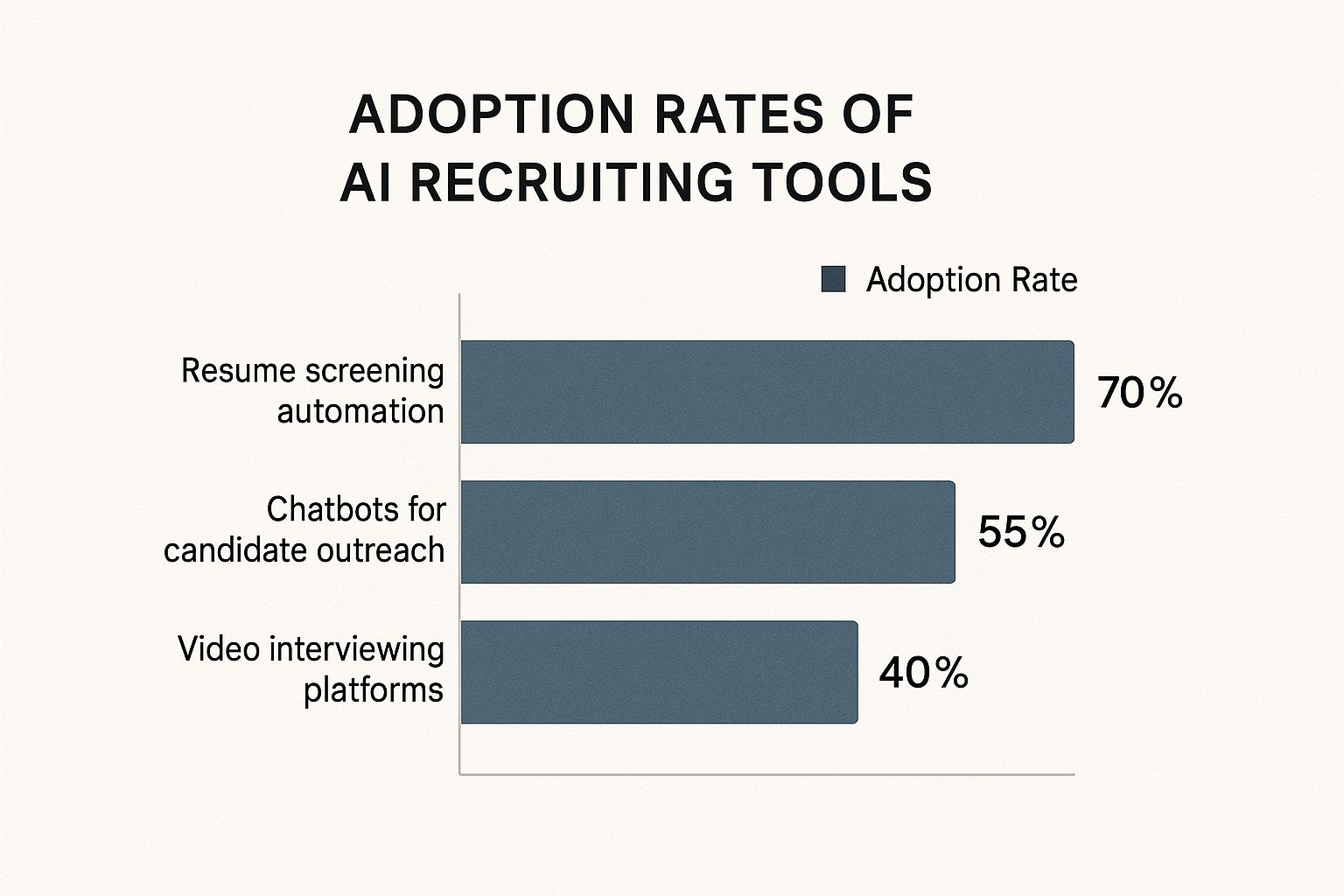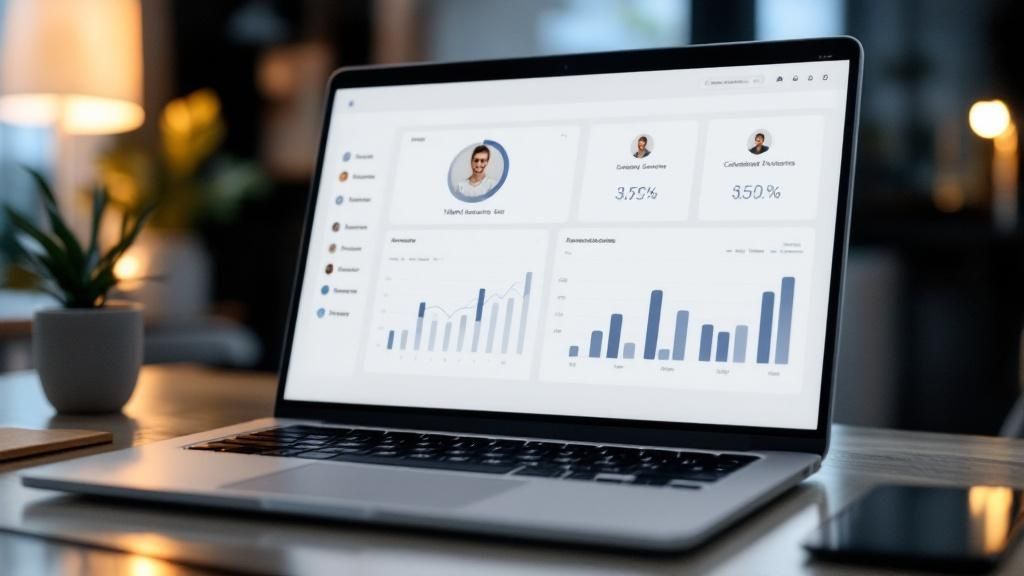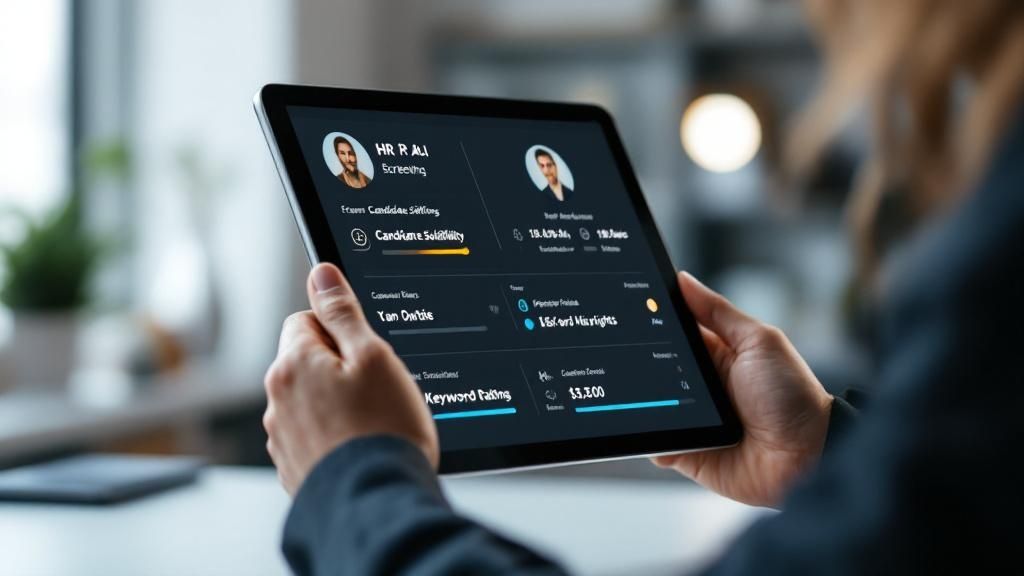August 4, 2025
How to Use AI in Recruiting A Modern Guide

When you think about using AI in recruiting, the real win isn't about replacing recruiters with robots. It’s about giving them a serious upgrade. The goal is to automate the grind—the endless resume screening and candidate sourcing—so your team can pour their energy into what really matters: building relationships and making smart, strategic hires.
Think of it this way: AI is the ultimate co-pilot. It handles the administrative heavy lifting, making the entire hiring process faster, more data-driven, and a whole lot less biased. This frees you up to focus on the distinctly human side of finding talent.
Beyond the Hype What AI Actually Does in Recruiting

Let's cut through the noise. The conversation around artificial intelligence in hiring often brings up images of cold, autonomous systems making the final call. The reality is much more practical and, frankly, more collaborative. AI isn’t here to take over; it’s here to supercharge the essential human judgment that defines great recruiting.
For top talent acquisition teams, AI is already a daily partner. Its core job is to automate and optimize the most time-consuming parts of the hiring cycle. Instead of a recruiter manually sifting through hundreds of resumes, an AI platform can analyze that same pile in seconds. It scores and ranks candidates based on the specific skills, experience, and qualifications you’ve set, letting your team immediately focus on the most promising people.
Amplifying Recruiter Productivity
This isn't just a theoretical boost; the numbers back it up. A recent PwC analysis found that since the rise of generative AI, productivity in highly exposed sectors has jumped from 7% to a staggering 27%. That's nearly a fourfold increase.
Those gains translate directly to recruiting. AI gives your team the bandwidth to handle higher candidate volumes while dramatically cutting down the time-to-hire. This efficiency comes from offloading specific, data-heavy tasks to technology that can do them faster and more consistently than any person ever could.
Here’s where it gets practical:
- Sourcing and Matching: AI tools can be your eyes across the internet, proactively scanning millions of profiles to find passive candidates who match your ideal profile—even when they aren't looking.
- Initial Screening: This is a big one. Algorithms instantly compare resumes to your job requirements, liberating recruiters from the manual review process that eats up so much of the week.
- Candidate Engagement: Let an AI-powered chatbot handle the frontline. It can answer initial questions, help schedule interviews, and give candidates status updates 24/7, ensuring a positive, responsive experience from the get-go.
Key Takeaway: The point isn't to remove the recruiter from the equation. It's to remove the tedious tasks that keep them from doing what they do best: assessing cultural fit, selling a great opportunity, and building genuine relationships with top candidates.
A Strategic Co-Pilot
When you start to see AI as a strategic partner, the entire game changes. It becomes a tool for making better-informed decisions, not just faster ones.
For instance, some of the more sophisticated platforms can analyze your job descriptions and flag biased or non-inclusive language you might have missed. This simple step helps you attract a more diverse—and often more qualified—talent pool right from the start. We dive deeper into this in our guide on using AI for talent acquisition.
Ultimately, learning how to use AI in recruiting is about understanding its strengths. It excels at processing huge amounts of data, finding patterns, and automating workflows. By embracing these capabilities, you empower your team to operate on a higher, more strategic level, turning talent acquisition into a true competitive edge for your company.
Choosing the Right AI Tools for Your Team
Building an AI-powered recruiting stack can feel overwhelming, but it doesn't have to be. The real key is to sidestep the temptation of chasing every shiny new tool and instead focus squarely on what will solve your team's most pressing challenges. Learning how to use AI in recruiting is less about a tech free-for-all and more about a strategic selection process.
The best place to start? A brutally honest assessment of your current workflow. Where are the bottlenecks? Are you drowning in resumes for high-volume roles? Is sourcing niche talent eating up all of your senior recruiters' time? Pinpointing your biggest headache will instantly narrow your search and ensure you invest in a solution that delivers immediate value.
Understanding the Main Tool Categories
AI recruitment software isn't a one-size-fits-all solution. Far from it. The tools are designed to solve very different problems. A small business struggling to keep up with a flood of applications has entirely different needs than a large enterprise trying to build proactive talent pipelines for future roles. Knowing the major categories is crucial for making a smart choice.
To help you get started, here's a look at the most common types of AI tools and the problems they're built to solve.
Key AI Recruitment Tool Categories and Their Functions
This table breaks down the main players in the AI recruiting space, what they actually do, and the specific headache they're designed to cure.
As you can see, choosing the right option is really about matching one of these solutions to your biggest recruiting pain point.
Evaluating Vendors and Ensuring Integration
Once you’ve identified the type of tool you need, the next hurdle is picking a vendor. Don't let slick marketing claims be your guide. I always recommend creating a simple scorecard to evaluate potential partners based on what truly matters to your team.
Here are a few non-negotiables to put on that scorecard:
- Seamless ATS Integration: This is a big one. The tool must talk to your existing Applicant Tracking System without creating extra work. Anything less defeats the entire purpose of automation. Ask for a live demo showing exactly how the two systems communicate.
- Total Cost of Ownership: Look beyond the sticker price. Are there hidden implementation costs, training fees, or extra charges for customer support? You need a crystal-clear picture of the total investment to build a solid business case.
- Ease of Use: If recruiters find the tool clunky or confusing, they simply won't use it. The interface should feel intuitive and require minimal training to get people up and running.
A critical—but often overlooked—factor is vendor transparency. Ask direct questions: How does your algorithm work? How do you test it for bias? What safeguards are in place to ensure fairness? A reputable partner will welcome these questions and give you straight answers.
The adoption of these tools is picking up steam fast, with some becoming standard practice across the industry. This chart gives you a sense of what's most popular right now.

It’s no surprise that tools solving the most universal recruiting headaches, like resume screening, have the highest adoption rates.
Ultimately, your goal is to build a tech stack where every tool serves a distinct purpose, working together to make your team more efficient and strategic. By focusing on your unique needs first and thoroughly vetting your options, you can confidently pick the right AI solutions that will empower your recruiters, not bury them in more work.
Integrating AI into Your Daily Hiring Workflow

This is where the rubber meets the road—moving your AI strategy from a plan on paper to a real, working part of your daily operations. Bringing AI into your hiring process doesn't mean you have to tear everything down and start over. It's more about weaving intelligent tools into specific, high-impact moments to make them faster and smarter.
The goal isn't to create chaos. It's to give your team a powerful co-pilot that can take over the draining, repetitive tasks. By targeting the right activities, you free up your recruiters to do what they do best: building real relationships with top-tier candidates and closing offers.
Crafting Better Job Descriptions with AI
Think about it: your job description is often the very first handshake between your company and a potential new hire. It has to be compelling, clear, and welcoming. This is a perfect place for AI to act as an incredible assistant, helping you get beyond generic templates and write descriptions that truly resonate with the right people.
For instance, you can run a draft through an AI writing assistant to check for:
- Inclusive Language: The tool can flag potentially biased phrases or gendered words that might unintentionally discourage great candidates from applying.
- Keyword Optimization: It can suggest the right keywords to boost your post’s visibility on job boards and search engines, making sure it gets in front of a much wider audience.
- Clarity and Readability: AI is great at spotting jargon and overly complex sentences, helping you make the role’s responsibilities and requirements easy for anyone to understand.
It’s like having an expert editor on call. Before you hit "publish," a quick AI review can seriously elevate the quality and reach of your job post, setting a much stronger foundation for the entire hiring cycle.
Automating the Initial Resume Screen
For any busy recruiting team, this is probably the single most impactful way to use AI. Manually sifting through hundreds of resumes for just one open role is not only a grind, but it's also where human error and unconscious bias can easily creep in. An AI screening tool completely changes the game.
By connecting an AI platform to your Applicant Tracking System (ATS), you can build a workflow that automatically analyzes every single application as it comes in. The system scores and ranks candidates based on the criteria you set—like specific skills, years of experience, or must-have certifications. This means your recruiters start their day with a qualified shortlist, not a mountain of resumes.
A common myth is that this takes human judgment out of the equation. In my experience, the opposite is true. By handling the high-volume grunt work, AI frees up recruiters to spend their time engaging with the most promising candidates, not just the first few they happen to click on.
There's a reason this is becoming standard practice. Research shows that 70% of global employers are now using AI-powered tools to improve how they source and screen candidates. By using algorithms to analyze massive datasets, they can pinpoint best-fit talent and drastically shorten the time-to-hire. Of course, they also recognize AI can't replace the human intuition needed for final decisions. You can dive deeper into these trends in Universum's latest research.
Deploying Chatbots for Candidate Engagement
We’ve all seen it happen. A candidate applies and then... silence. That waiting period can feel like a black hole, leading to frustration and a poor impression of your company. AI-powered chatbots are the perfect fix for this, offering instant, 24/7 engagement.
Here’s a real-world scenario of how to use AI in recruiting to create a better candidate experience:
- Immediate Confirmation: A candidate applies for a role on your careers page at 10 PM on a Friday. A chatbot instantly confirms their application was received. No waiting until Monday.
- Answering FAQs: The candidate then asks, "What are the next steps?" The chatbot immediately provides a clear, simple timeline of your review process.
- Scheduling Interviews: For candidates who meet the initial qualifications, the chatbot can even tap into your team's calendars to find a good time for a screening call and send the invite automatically.
This kind of seamless interaction doesn't just improve the candidate's journey; it also kills the endless administrative back-and-forth that eats up a recruiter's day. It guarantees every single applicant feels seen and informed—a huge win for your employer brand. The key is to view AI as your co-pilot, not the autopilot, keeping a human in the loop for the critical, relationship-building steps that really matter.
Using AI for Proactive Candidate Sourcing and Matching

Let's be honest, the old "post and pray" method of recruiting is a thing of the past. Your ideal candidates probably aren't scrolling through job boards—they're too busy excelling in their current roles. This is where AI gives you a serious strategic edge, helping you pivot from a reactive waiting game to a proactive talent hunt.
Think of AI-powered sourcing tools as your digital scouts. They work around the clock, scanning professional networks, niche online communities, and even your own databases to find top-tier talent. They don't just pull names; they build out rich, detailed profiles that give you a much clearer picture of a person than any standard resume could.
Moving Beyond Simple Keywords
The real power of AI matching is its ability to think conceptually, not just literally. A traditional ATS might get stuck searching for the exact phrase "Java Developer." An AI platform, on the other hand, understands context. It knows to look for related skills like Spring Boot, microservices, and cloud platform experience, correctly identifying them as signs of a great candidate even if the buzzwords aren't a perfect match.
This deeper analysis allows the AI to rank and score potential candidates based on a complete view of their abilities. It doesn't just see what they've done; it sees what they're capable of doing next. The result? A highly qualified, prioritized talent pipeline lands right on your team's desk, saving countless hours of manual sifting.
Of course, technology alone isn't a silver bullet. You can explore more advanced candidate sourcing strategies in our dedicated guide to see how to pair these tools with smart human tactics.
Uncovering Hidden Gems in Your Own Backyard
One of the most overlooked goldmines for talent is your own company. You likely have incredible people already on your payroll, but it's nearly impossible to keep track of their evolving skills and career goals manually. This is where AI sourcing shines. It can continuously scan your internal employee database and flag them for new openings they’d be perfect for.
Here’s a real-world example of how this plays out:
- A project manager in your marketing department has been taking online courses in data analytics on her own time.
- The product team opens a new "Product Analyst" position.
- The AI connects the dots, flagging the project manager as a high-potential internal candidate based on her new skills and existing institutional knowledge.
This does more than just fill roles faster. It's a massive boost for internal mobility and employee retention. People are far more likely to stay with a company that actively recognizes their growth and provides clear paths to advance.
Key Insight: AI sourcing transforms your talent pool from a static list of applicants into a dynamic, living ecosystem. It helps you find promising people—both outside and inside your company—who you would have otherwise completely missed.
This isn't just a theory; hiring managers are seeing the results. A recent 2025 AI in Hiring Report from Insight Global highlights this shift. The report found that 74% of managers believe AI helps assess if a candidate’s skills align with job requirements, and 73% agree it can identify current employees for other internal roles. With 95% of hiring managers planning to increase their tech investment, smart talent mobility is clearly the future.
Diversifying Your Talent Pool
We all have unconscious biases that can lead us to search in the same familiar places and draw from the same talent pools. AI sourcing tools are designed to break that cycle. They're programmed to cast a much wider net, exploring a diverse range of platforms, forums, and online communities without any preconceived notions.
By focusing purely on skills, experience, and potential, these tools can surface exceptional candidates from underrepresented groups and those with non-traditional career paths. This doesn't just help you build a more diverse and inclusive workforce—it injects fresh perspectives and innovative ideas into your organization. It’s a powerful way to make sure you’re truly hiring the best person for the job, regardless of where they came from.
Measuring the ROI of Your AI Recruiting Strategy
Getting your new AI tools up and running is a huge milestone, but the real work has just begun. To truly justify the investment and build a case for future budgets, you need to prove its value with cold, hard data. This isn't about gut feelings; it’s about showing the tangible return on investment (ROI) your AI recruiting strategy is delivering.
Think of it this way: measuring ROI isn't just a box-ticking exercise for the C-suite. It's your roadmap for continuous improvement. When you know exactly what’s working—and what isn't—you can make smarter decisions, fine-tune your workflows, and ensure the tech is genuinely making your team’s life easier. The right metrics tell a powerful story about efficiency, quality, and experience.
Key Performance Indicators to Track
To build a compelling business case, you have to connect your AI tools directly to core recruiting outcomes. While every company’s needs are a bit different, a few KPIs are universally critical for showing real value.
The most important first step? Get your baseline numbers before you flip the switch on your new AI. That pre-implementation data is your benchmark. Without it, you can’t prove a thing.
- Time-to-Hire: A classic for a reason. How many days does it actually take to get a candidate from application to offer acceptance? AI should slash this by automating tedious screening and scheduling, and you need the before-and-after numbers to prove it.
- Cost-per-Hire: Do the math. Tally up everything from advertising spend and technology fees to the cost of your team's time. Good AI tools shrink this number by improving efficiency and getting you to the right candidates faster, which means less money down the drain.
- Quality of Hire: This one is the holy grail of recruiting metrics, but it’s also the trickiest to pin down. You can get a solid read on it by tracking things like performance review scores, promotion rates, and retention of new hires at the six and twelve-month marks. A great AI tool doesn’t just find someone to fill a seat; it finds someone who will thrive.
This focus on core KPIs changes the conversation entirely. Instead of saying, "We're using AI," you can say, "Our AI tools cut time-to-hire by 30% and boosted new hire performance by 15%." Now that's a story that gets people's attention.
Analyzing the Human Impact
Numbers are great, but they don't tell the whole story. The true success of AI in recruiting also hinges on how it affects the people involved—your team and your candidates. Gathering this qualitative feedback is essential for seeing the complete ROI picture.
It’s crucial to understand the experience from both sides of the hiring desk. Is this new technology a lifesaver, or is it just another frustrating login? We dive much deeper into creating a better experience in our guide on how to improve the recruitment process.
A Framework for Gathering Feedback
Don't leave feedback to chance. Set up a regular rhythm for collecting these insights. A simple, structured approach is all you need to get consistent, actionable information.
Think of this feedback as your early-warning system. It helps you catch adoption issues before they become major problems, pinpoint where more training is needed, and make smart tweaks to your AI tools.
When you pair powerful quantitative KPIs with this kind of rich, human feedback, you build an unshakeable case for your AI recruiting strategy. You're not just showing that it works; you're showing how it makes your entire hiring process better for everyone.
Common Questions About AI in Recruiting
https://www.youtube.com/embed/f8Hyczfjfyc
Even with all the obvious upsides, bringing new technology into your hiring process can feel like a huge leap. It’s completely natural to have questions. Getting clear, straightforward answers is the best way to feel confident about bringing AI tools into your recruiting workflow.
Let's walk through some of the most common questions recruiters and hiring managers have when they first start looking into AI. Getting these sorted out upfront can make all the difference for a successful rollout.
Will AI Replace Recruiters and Hiring Managers?
This is probably the biggest question out there, and the one that causes the most anxiety. The short answer is no. Think of AI as a powerful co-pilot, not the pilot.
Its real strength is in taking over the repetitive, high-volume tasks that eat up a recruiter’s day. We’re talking about things like the initial resume screen, coordinating interview schedules, or sending out routine follow-up messages. These are perfect jobs for a machine.
This frees you and your team up for the work that truly requires a human touch: building strong relationships with candidates, conducting meaningful interviews, and making those final, nuanced hiring decisions. The goal is always to augment your team's skills, not to automate them out of a job.
How Can We Ensure AI Tools Are Fair and Unbiased?
This is a critical concern, and frankly, it should be. The risk of algorithmic bias is very real, but it’s something you can manage with the right strategy. It all starts with picking reputable vendors who are transparent about how they build, test, and audit their tools for fairness.
To keep bias in check, you should:
- Insist on a "human-in-the-loop" model. This means the AI makes recommendations, but your team makes the final call. This keeps human judgment and context right where they belong—at the center of your process.
- Regularly audit your results. Are the candidates shortlisted by the AI just as diverse as your overall applicant pool? You need to check and make sure it isn't accidentally filtering out certain groups.
- Drill down with your vendors. Ask them point-blank what steps they take to find and stamp out bias in their systems. A good partner will have clear, confident answers.
A well-designed AI can actually reduce the unconscious human biases that often creep into hiring. By focusing purely on skills and qualifications, it gives every single application the same impartial first look.
Can Small Recruiting Teams Afford to Use AI?
Absolutely. The idea that AI is only for massive corporations with bottomless budgets is a total myth. The market for AI recruiting software has exploded, and there are now fantastic, affordable options for teams of any size.
Many modern tools are accessible because of flexible pricing, such as:
- Tiered subscriptions so you only pay for the features you actually use.
- Pay-per-use plans for specific tasks, like screening resumes for a single opening.
- Scalable solutions that can grow right alongside your company.
The trick for a smaller team is to start with a laser focus. Pinpoint your single biggest bottleneck—whether that’s sourcing candidates or scheduling interviews—and find a tool that solves that one specific problem. You'll see an immediate return on your investment, making it an easy win to justify.
How Do I Get My Team to Adopt New AI Tools?
Change management is always a hurdle, but successful adoption comes down to smart strategy and great communication. You can't just drop a new platform on your team and hope for the best.
First, you have to sell the "why." Clearly explain how the tool will cut down their admin work, help them hit hiring goals faster, and let them focus on the parts of the job they actually enjoy. You need to frame it as something that helps them win.
From there, a phased rollout is your best bet. Start a small pilot program with a few of your most enthusiastic team members—your "internal champions." Give them excellent training and support. Once they start seeing great results and sharing their positive experiences, their colleagues will be much more eager to jump on board. Highlighting those early successes is the secret to building momentum.
Ready to see how a dedicated AI co-pilot can transform your hiring process? Klearskill offers a powerful, intuitive solution that eliminates manual screening, reduces bias, and helps you pinpoint the best candidates in record time. Discover a smarter way to hire at https://www.klearskill.com.
